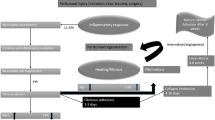Abstract
In marked contrast to the clinical impression of practitioners, postoperative adhesion development occurs following most surgical procedures.1–3 This misimpression of clinicians is most likely the result of their inability to view the intraperitoneal operative sites following a surgical procedure without a repeat operation, for which there is frequently no clinical indication. Because many of the complications these adhesions may cause can occur years or decades after the inciting event, the cause-and-effect relationship is often lost. Furthermore, the rare opportunities to perform a second operative procedure, with exceptions, result from a complication in the immediate postoperative period such as an infection or bleeding. In such situations, the finding of adhesions would not be a surprise to the surgeon.
Access this chapter
Tax calculation will be finalised at checkout
Purchases are for personal use only
Preview
Unable to display preview. Download preview PDF.
Similar content being viewed by others
References
Diamond MP, DeCherney AH. Pathogenesis of adhesion formation/reformation: application to reproductive pelvic surgery. Microsurgery 1987; 8:103–107.
Diamond MP, Daniell JF, Feste J, et al. Adhesion reformation and de novo adhesion formation following reproductive pelvic surgery. Fertil Steril 1987; 47:864–866.
Diamond MP, Daniell JF, Johns DA, et al. Postoperative adhesion development following operative laparoscopy: evaluation at early second-look procedures. Fertil Steril 1991; 55:700–704.
Diamond MP. Surgical aspects of infertility. In Sciarra JJ, ed. Gynecology and Obstetrics, Vol. 5. Philadelphia: Harper & Row, 1995:1–26.
Diamond MP, Feste J, McLaughlin DS, et al. Pelvic adhesions at early second-look laparoscopy following carbon dioxide laser surgery. Infertility 1984; 7:39–44.
Raj SG, Hulka JF. Second-look laparoscopy in infertility surgery: therapeutic and prognostic valve. Fertil Steril 1982; 49:26.
DeCherney AH, Mezer HC. The nature of posttuboplasty pelvic adhesions as determined by early and late laparoscopy. Fertil Steril 1984; 41:643.
Surrey MW, Friedman S. Second-look laparoscopy after reconstructive pelvic surgery for infertility. J Reprod Med 1982; 27:658.
Pittaway DE, Daniell JF, Maxson WS. Ovarian surgery in an infertility patient as an indication for a short-interval second-look laparoscopy: a preliminary study. Fertil Steril 1985; 44:611.
Trimbos-Kemper TCM, Trimbos JB, van Hall EV. Adhesion formation after tubal surgery: results of the eighth-day laparoscopy in 188 patients. Fertil Steril 1985; 43:395.
Daniell JF, Pittaway DE. Short-interval second-look laparoscopy after infertility surgery: a preliminary report. J Re-prod Med 1983; 28:281.
Diamond MP, Daniell JF, Johns DA, et al. Postoperative adhesion development following operative laparoscopy: evaluation at early second-look procedures. Fertil Steril 1991; 55:700–704.
Diamond MP, Seprafilm™ Adhesion Study Group. Reduction of adhesions after uterine myomectomy by Seprafilm™ (HAW™),* a blinded prospective, randomized, multicenter clinical study. Fertil Steril 1996; 66:904–910.
Diamond MP, Nezhat F. Letter to the Editor: Adhesions after resection of ovarian endometriomas. Fertil Steril 1993; 59:934–935.
Diamond MP, Sepracoat Adhesion Study Group. Reduction of de novo postsurgical adhesions by intraoperative precoating with sepracoat (HAL-C) solution: a prospective, randomized, blinded, placebo-controlled multicenter study. Fertil Steril 1998; 69:1067–1073.
Azziz R, Cohen S, Curole DN, et al. Pelvic sidewall adhesion reformation: microsurgery alone or with Interceed absorbable adhesion barrier. Surg Gynecol Obstet 1993; 177:135–139.
Sekiba K. Use of Interceed (TC7) absorbable adhesion barrier to reduce postoperative adhesion reformation in infertility and endometriosis surgery. Obstet Gynecol 1992; 79:518–522.
Becker JM, Dayton MT, Fazio VW, et al. Prevention of postoperative abdominal adhesions by a sodium hyaluronate-based bioresorbable membrane: a prospective, randomized, double-blind multicenter study. J Am Coll Surg 1996; 183:297–306.
Franklin RR, Diamond MP, Malinak LR, et al. Reduction of ovarian adhesions by the use of Interceed. Obstet Gynecol 1995; 86(3):335–340.
Nordic Adhesion Prevention Study Group. The efficacy of Interceed (TC7)* for prevention of reformation of postoperative adhesions on ovaries, fallopian tubes, and fim-briae in microsurgical operations for fertility: a multi-center study. Fertil Steril 1995; 63:709–714.
Wiseman DM, Trout JR, Diamond MP. The rates of adhesion development and the effects of crystalloid solutions on adhesion development in pelvic surgery. Fertil Steril 1998: 70:702–711.
Editor information
Editors and Affiliations
Rights and permissions
Copyright information
© 2000 Springer Science+Business Media New York
About this chapter
Cite this chapter
Diamond, M.P. (2000). Incidence of Postsurgical Adhesions. In: diZerega, G.S. (eds) Peritoneal Surgery. Springer, New York, NY. https://doi.org/10.1007/978-1-4612-1194-5_17
Download citation
DOI: https://doi.org/10.1007/978-1-4612-1194-5_17
Publisher Name: Springer, New York, NY
Print ISBN: 978-1-4612-7040-9
Online ISBN: 978-1-4612-1194-5
eBook Packages: Springer Book Archive




